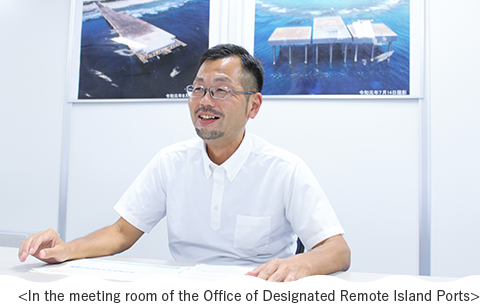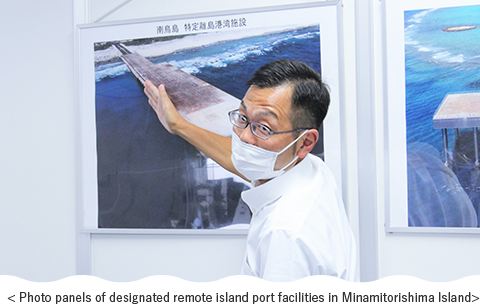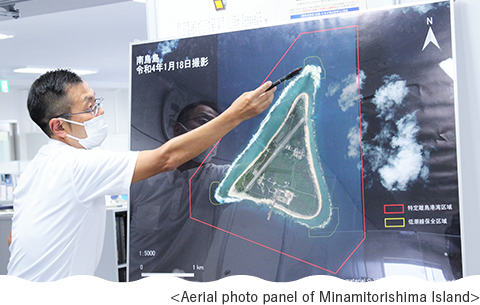
A. "The Act on the Preservation of Low Tide Levels and Development of Infrastructure to Preserve and Facilitate Use of Exclusive Economic Zones (EEZ) and the Continental Shelf" (the Act on the Preservation of Low Tide Levels) came into effect in 2010. This law provides that the Minister of Land, Infrastructure, Transport and Tourism is to develop port facilities on designated remote islands away from the mainland as a base of operations for the conservation and use of the EEZ, including the development and use of marine resources. Also, these facilities allow for the mooring, anchoring, and cargo handling of ships. Following the rule, the Office of Designated Remote Island Ports is primarily responsible for developing, using, preserving, and managing activity base facilities on Okinotorishima Islands and Minamitorishima Island. The development of port facilities on designated remote islands began in 2010, while the office started in 2015.
A. Our department is responsible for the construction, improvement, and management of port facilities used for government operations and projects related to designated remote islands and the regulation of the occupation of certain water areas. Also, it oversees regulating activities in the area that preserves the low tide levels, which are the starting point of the EEZ. I primarily manage these operations.
A. For Japan, which has a vast exclusive EEZ and aims to become a maritime nation, activities related to developing and utilizing marine resources and oceanographic research have attracted attention. However, for these activities to be conducted safely and stably even in waters far from the mainland, a base of operations is needed on remote islands to enable transportation, supply, and shelter during stormy weather. Therefore, in June 2010, Okinotorishima Islands and Minamitorishima Island were classified as designated remote islands that need to develop as bases for such activities under the Act on the Preservation of Low Tide Levels.
A. Before 2010, there were no port facilities.

A. The facility construction on Okinotorishima Islands is planned to be in place from 2011 through April 2028. The project for the facility on Minamitorishima Island began in 2010 and expects to complete by April 2023.

A. Because the construction will take place far from Tokyo, a fleet of vessels will need to travel to the island to transport many workers, crews, heavy equipment operators, and materials and equipment. We must transport all necessary machinery and materials without excess. In addition, there is the issue of weather. Particularly, Okinotorishima Islands have unstable wave conditions. Therefore, it is impossible to carry out construction work at any time of the year, and it is difficult to proceed with construction work as planned within a limited period. During stormy weather, such as typhoons, strong winds, and high waves can make it dangerous to stay on Okinotorishima Islands, so the work fleet may retreat to Okinawa, Kagoshima, or other locations where they can anchor. Since weather conditions are critical, a weather forecaster will accompany the site work.
A. The staff conducts daily patrols to manage the specified remote island port facilities, the specified remote island port area, and the waters of the low-tide level. Also, they inspect the national property on the island for damage and supervise construction work related to the maintenance of facilities.
A. We travel to Okinotorishima Island by a fleet of work ships and live on the vessel. Construction supervisors such as ourselves and the operator who has received the construction order spend time on the same boat, and each of us has our own office on board. Unlike Minamitorishima Island, which has a harbor preservation management office, we locate it on the vessel in the case of Okinotorishima Islands.

A. In the waters surrounding Okinotorishima Islands, surveys and research are being conducted by related organizations. However, since there are no port facilities, materials and equipment must be transshipped from the main ship to small ships and boats offshore for marine transportation. Therefore, the construction of port facilities, including a harbor road, will enable the safe and efficient unloading of materials and equipment and the landing of workers.

A. It leads to improving the efficiency of goods transportation for institutions operating on Minamitorishima Island, improving the efficiency of operation of research vessels and other ships in the surrounding waters, and forming a base for developing marine resources. Furthermore, since Minamitorishima Island is the site of active activities by research institutes, I expect that research and post-research projects will proceed efficiently through the effective use of port facilities.
A. I visited Okinotorishima Islands in 2021 for supervisory duties and stayed there for 1.5 months. Also, I visited Minamitorishima Island twice, in 2021 and 2022. It was the first time for me to work as a construction supervisor on a working ship and live on a remote island, and to be honest, I was very anxious and prepared for the work. There is no shade on the island, so it is essential to take all possible measures to prevent heat stroke. Also, since rain squall is usual in the area, it was necessary to keep a close eye on the weather and sea conditions as needed. Thanks to these efforts, I could carry out my work without accidents or disasters. Although there were many hardships, I think it was a significant and valuable experience. I also have good memories of living with people from other ministries and deepening exchanges with them.
A. In the waters surrounding Okinotorishima Islands and Minamitorishima Island, located far from Tokyo, various organizations are conducting multiple activities under laws and regulations. Therefore, we will continue to promote the development of base facilities with safety first to steadily implement and enhance measures to conduct activities safely and stably.